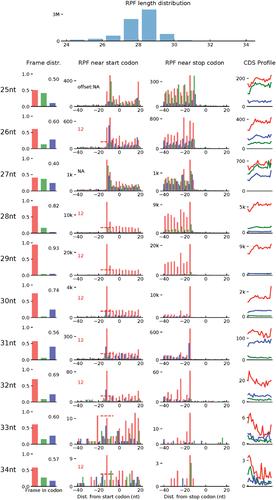{"title":"deltaTE: Detection of Translationally Regulated Genes by Integrative Analysis of Ribo-seq and RNA-seq Data","authors":"Sonia Chothani, Eleonora Adami, John F. Ouyang, Sivakumar Viswanathan, Norbert Hubner, Stuart A. Cook, Sebastian Schafer, Owen J. L. Rackham","doi":"10.1002/cpmb.108","DOIUrl":null,"url":null,"abstract":"<p>Ribosome profiling quantifies the genome-wide ribosome occupancy of transcripts. With the integration of matched RNA sequencing data, the translation efficiency (TE) of genes can be calculated to reveal translational regulation. This layer of gene-expression regulation is otherwise difficult to assess on a global scale and generally not well understood in the context of human disease. Current statistical methods to calculate differences in TE have low accuracy, cannot accommodate complex experimental designs or confounding factors, and do not categorize genes into buffered, intensified, or exclusively translationally regulated genes. This article outlines a method [referred to as deltaTE (ΔTE), standing for change in TE] to identify translationally regulated genes, which addresses the shortcomings of previous methods. In an extensive benchmarking analysis, ΔTE outperforms all methods tested. Furthermore, applying ΔTE on data from human primary cells allows detection of substantially more translationally regulated genes, providing a clearer understanding of translational regulation in pathogenic processes. In this article, we describe protocols for data preparation, normalization, analysis, and visualization, starting from raw sequencing files. © 2019 The Authors.</p><p><b>Basic Protocol</b>: One-step detection and classification of differential translation efficiency genes using DTEG.R</p><p><b>Alternate Protocol</b>: Step-wise detection and classification of differential translation efficiency genes using R</p><p><b>Support Protocol</b>: Workflow from raw data to read counts</p>","PeriodicalId":10734,"journal":{"name":"Current Protocols in Molecular Biology","volume":"129 1","pages":""},"PeriodicalIF":0.0000,"publicationDate":"2019-10-17","publicationTypes":"Journal Article","fieldsOfStudy":null,"isOpenAccess":false,"openAccessPdf":"https://sci-hub-pdf.com/10.1002/cpmb.108","citationCount":"54","resultStr":null,"platform":"Semanticscholar","paperid":null,"PeriodicalName":"Current Protocols in Molecular Biology","FirstCategoryId":"1085","ListUrlMain":"https://onlinelibrary.wiley.com/doi/10.1002/cpmb.108","RegionNum":0,"RegionCategory":null,"ArticlePicture":[],"TitleCN":null,"AbstractTextCN":null,"PMCID":null,"EPubDate":"","PubModel":"","JCR":"Q2","JCRName":"Biochemistry, Genetics and Molecular Biology","Score":null,"Total":0}
引用次数: 54
Abstract
Ribosome profiling quantifies the genome-wide ribosome occupancy of transcripts. With the integration of matched RNA sequencing data, the translation efficiency (TE) of genes can be calculated to reveal translational regulation. This layer of gene-expression regulation is otherwise difficult to assess on a global scale and generally not well understood in the context of human disease. Current statistical methods to calculate differences in TE have low accuracy, cannot accommodate complex experimental designs or confounding factors, and do not categorize genes into buffered, intensified, or exclusively translationally regulated genes. This article outlines a method [referred to as deltaTE (ΔTE), standing for change in TE] to identify translationally regulated genes, which addresses the shortcomings of previous methods. In an extensive benchmarking analysis, ΔTE outperforms all methods tested. Furthermore, applying ΔTE on data from human primary cells allows detection of substantially more translationally regulated genes, providing a clearer understanding of translational regulation in pathogenic processes. In this article, we describe protocols for data preparation, normalization, analysis, and visualization, starting from raw sequencing files. © 2019 The Authors.
Basic Protocol: One-step detection and classification of differential translation efficiency genes using DTEG.R
Alternate Protocol: Step-wise detection and classification of differential translation efficiency genes using R
Support Protocol: Workflow from raw data to read counts

deltaTE:通过RNA-seq和核糖核酸-seq数据的综合分析检测翻译调控基因
核糖体分析量化转录本的全基因组核糖体占用率。通过整合匹配的RNA测序数据,可以计算出基因的翻译效率(TE),从而揭示翻译调控。否则,这一层基因表达调控很难在全球范围内进行评估,而且在人类疾病的背景下通常也没有得到很好的理解。目前计算TE差异的统计方法准确性较低,不能适应复杂的实验设计或混杂因素,并且不能将基因分为缓冲基因、强化基因或完全翻译调节基因。本文概述了一种识别翻译调节基因的方法[称为deltaTE (ΔTE),代表TE的变化],该方法解决了以前方法的缺点。在广泛的基准分析中,ΔTE优于所有测试方法。此外,将ΔTE应用于人类原代细胞的数据,可以检测到更多的翻译调节基因,从而更清楚地了解致病过程中的翻译调节。在本文中,我们将从原始测序文件开始,描述用于数据准备、规范化、分析和可视化的协议。©2019作者。基本方案:使用DTEG一步检测和分类差异翻译效率基因。RAlternate协议:使用RSupport协议逐步检测和分类差异翻译效率基因:从原始数据到读取计数的工作流程
本文章由计算机程序翻译,如有差异,请以英文原文为准。



